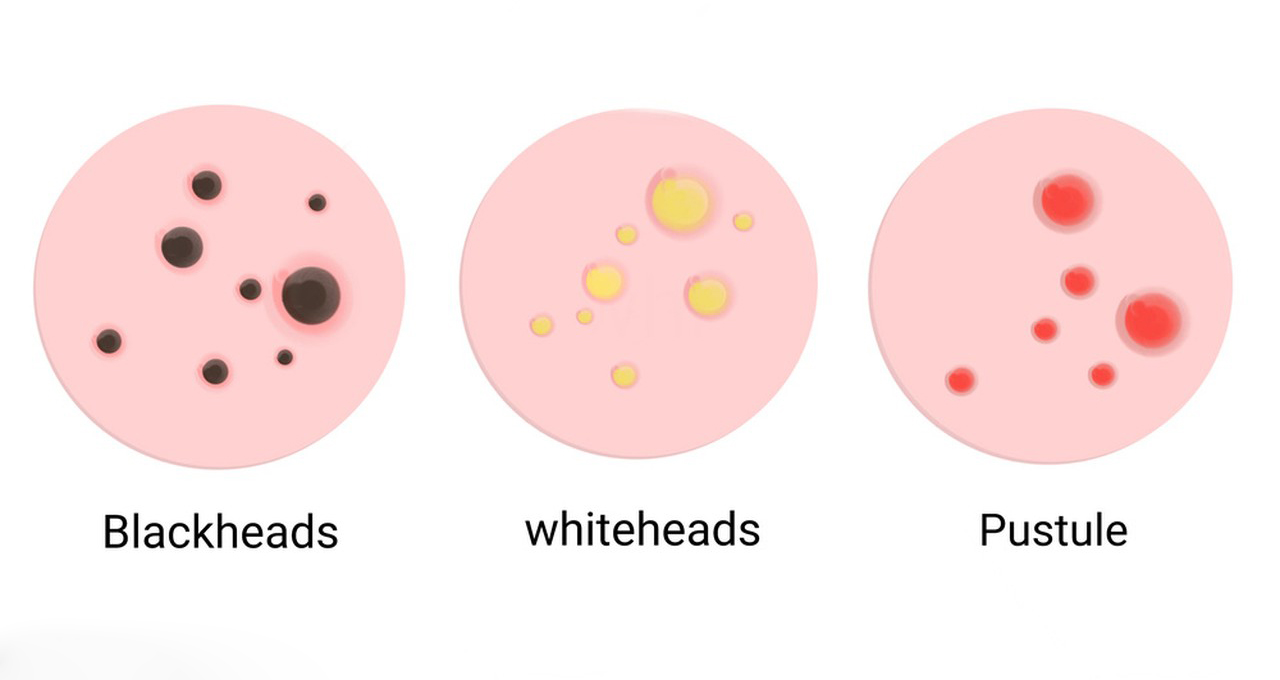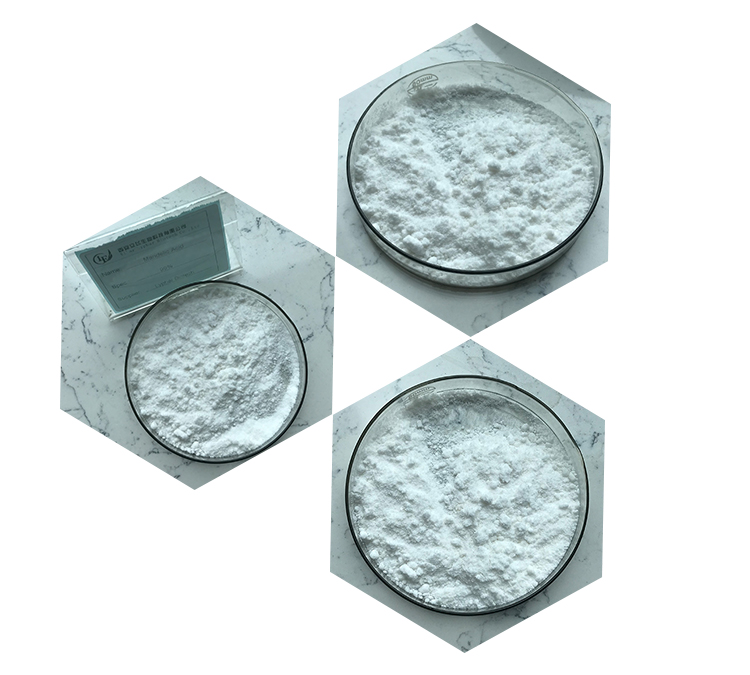1. Introduction to Mandelic Acid
Mandelic acid is an alpha hydroxy acid (AHA) derived from bitter almonds. It is known for its gentle exfoliating properties and is commonly used in skincare for treating various skin conditions. Unlike glycolic or lactic acids, which are smaller and more aggressive, mandelic acid has a larger molecular structure, making it slower to penetrate the skin. This slower absorption reduces irritation, making it suitable for sensitive skin types.
2. Chemical Structure
- IUPAC Name: 2-hydroxy-2-phenylacetic acid
- Molecular Formula: C8H8O3
- Molar Mass: 152.15 g/mol
- Structure: It consists of a benzene ring (phenyl group) attached to an alpha-hydroxy carboxylic acid chain, with a hydroxyl group (-OH) and a carboxyl group (-COOH).
3. Sources and Synthesis
Mandelic acid can be found naturally in bitter almonds. It can also be synthesized through the hydrolysis of mandelonitrile, a compound that forms as an intermediate during the degradation of amygdalin (a compound in bitter almonds). The industrial production typically involves chemical processes such as the oxidation of phenylglycine or the reaction of benzaldehyde with glycine in the presence of cyanide.

4. Mechanism of Action
As an AHA, mandelic acid works primarily by breaking the bonds between dead skin cells, promoting exfoliation and revealing newer, healthier skin layers beneath. It also stimulates the production of collagen, elastin, and other proteins that support skin structure.
- Exfoliation: It weakens the cohesion of corneocytes (the dead cells of the skin’s outer layer), allowing them to shed more easily.
- Antimicrobial: Mandelic acid has antibacterial properties, especially against Propionibacterium acnes, the bacteria associated with acne formation.
- Skin Lightening: It inhibits the synthesis of melanin by interfering with tyrosinase, an enzyme involved in pigmentation, thus helping reduce hyperpigmentation.
5. Uses in Skincare
A. Acne Treatment
- Mandelic acid is particularly effective in treating inflammatory acne due to its antibacterial properties and gentle exfoliation.
- It helps in unclogging pores, reducing sebum production, and controlling the formation of new acne lesions.
B. Anti-aging
- Mandelic acid promotes cell turnover, which helps reduce the appearance of fine lines and wrinkles.
- It stimulates collagen production, improving skin texture and firmness over time.
C. Hyperpigmentation
- Due to its ability to inhibit melanin production, mandelic acid is used to treat dark spots, melasma, and post-inflammatory hyperpigmentation.
- It is commonly combined with other lightening agents like kojic acid and vitamin C for enhanced results.
- Rosacea and Sensitive Skin
- Its gentle exfoliating nature makes it suitable for people with sensitive skin or conditions like rosacea, which may react negatively to harsher AHAs.
- It helps in reducing redness and inflammation without causing irritation.
6. Comparative Analysis with Other AHAs
| Characteristic | Mandelic Acid | Glycolic Acid | Lactic Acid |
| Molecular Size | Large | Small | Medium |
| Penetration Rate | Slow | Fast | Moderate |
| Irritation Potential | Low | High | Low to Moderate |
| Skin Types | Sensitive, acne-prone | Normal, oily, aging skin | Dry, sensitive |
| Primary Uses | Acne, hyperpigmentation | Anti-aging, exfoliation | Hydration, mild exfoliation |
Mandelic acid stands out for its balance between efficacy and gentleness, making it ideal for sensitive or reactive skin types. Glycolic acid, on the other hand, is more potent and suitable for people who can tolerate stronger exfoliation, while lactic acid focuses on hydration along with mild exfoliation.
7. Side Effects and Considerations
Mandelic acid, though gentler than other AHAs, can still cause some side effects if not used properly:
- Sun Sensitivity: Like other exfoliants, mandelic acid can make the skin more sensitive to UV radiation, increasing the risk of sunburn. It is recommended to use sunscreen daily when incorporating mandelic acid into a skincare routine.
- Mild Irritation: In rare cases, users may experience mild redness, peeling, or dryness, especially if they overuse the product or have compromised skin barriers.
- Allergic Reactions: Though rare, allergic reactions to mandelic acid can occur, often due to the presence of other ingredients in formulations. A patch test is advisable before full use.
8. Formulations and Product Types
Mandelic acid is available in various product formulations, including:
- Cleansers: Used for gentle daily exfoliation without being too harsh.
- Serums: Concentrated treatments for targeted issues like acne or hyperpigmentation.
- Peels: Higher concentrations for professional or at-home use to deeply exfoliate the skin.
- Toners: Provide a milder exfoliation, ideal for beginners or those with very sensitive skin.
Common concentrations range from 5% to 10% in over-the-counter products, while higher percentages (up to 20-30%) are used in chemical peels administered by professionals.

9. Mandelic Acid in Dermatological Procedures
In clinical settings, mandelic acid is often used in chemical peels to treat:
- Photoaging: Reverses signs of sun damage like fine lines, wrinkles, and pigmentation.
- Melasma: Effective in reducing deep-rooted pigmentation issues.
- Acne: Regular use of mandelic acid peels helps control persistent acne and reduce scarring.
Its slow absorption and lower irritation make it a preferred choice for patients with darker skin tones, as it carries a lower risk of post-inflammatory hyperpigmentation compared to other AHAs.
10. Recent Research and Innovations
- Combination Treatments: Studies show that combining mandelic acid with salicylic acid or niacinamide enhances acne treatment efficacy.
- Nanotechnology: New delivery systems involving nanocarriers for mandelic acid have been developed to increase skin penetration and reduce potential side effects.
- Post-acne Hyperpigmentation: Ongoing research focuses on the role of mandelic acid in reducing long-term acne scars and pigmentation.
11. Conclusion
Mandelic acid is a versatile and effective ingredient in skincare, especially for those with sensitive, acne-prone, or hyperpigmented skin. Its large molecular size and slower absorption rate allow it to work effectively while minimizing irritation. As research continues to explore new formulations and combinations, mandelic acid remains a staple for addressing a variety of skin concerns, from acne to aging.
Would you like to explore any particular aspect of mandelic acid in more detail?
